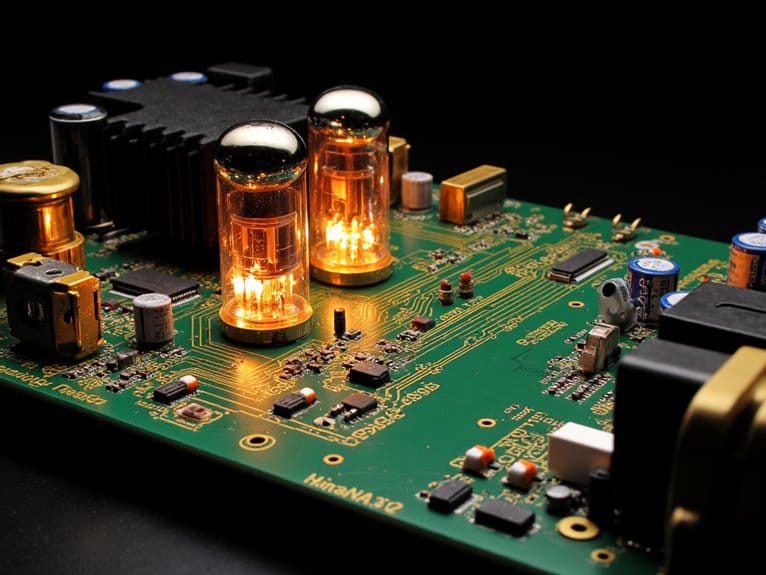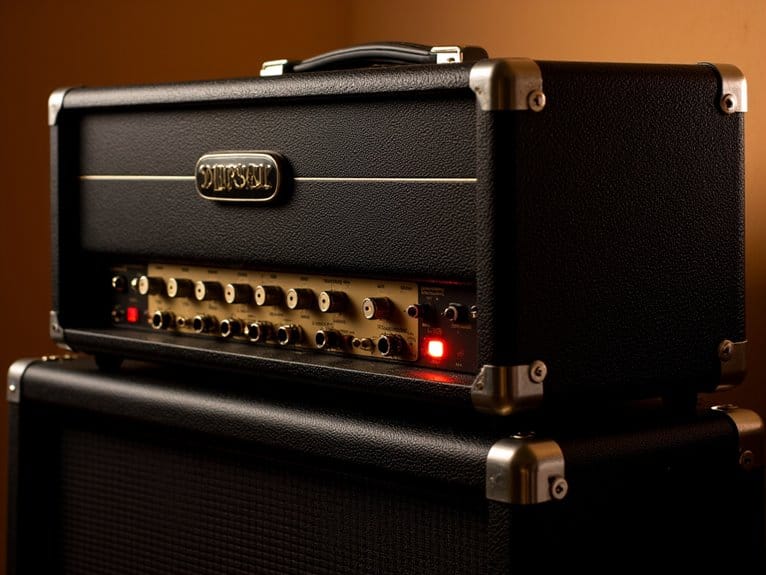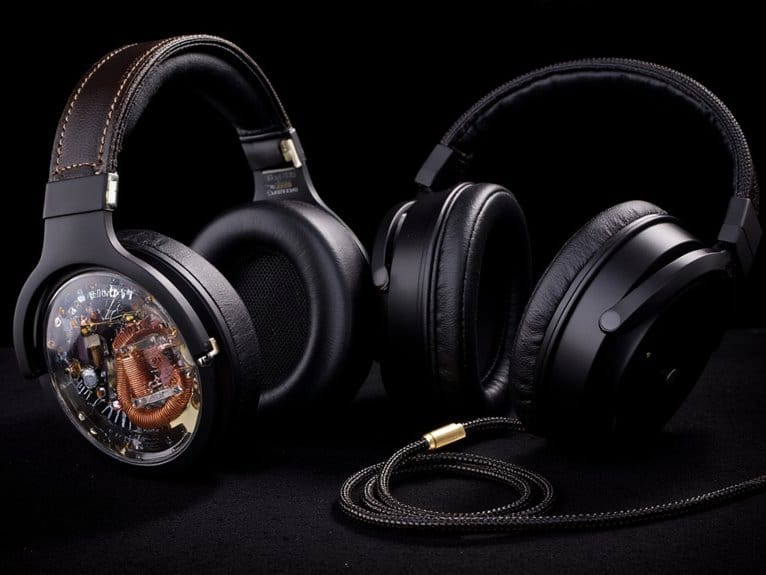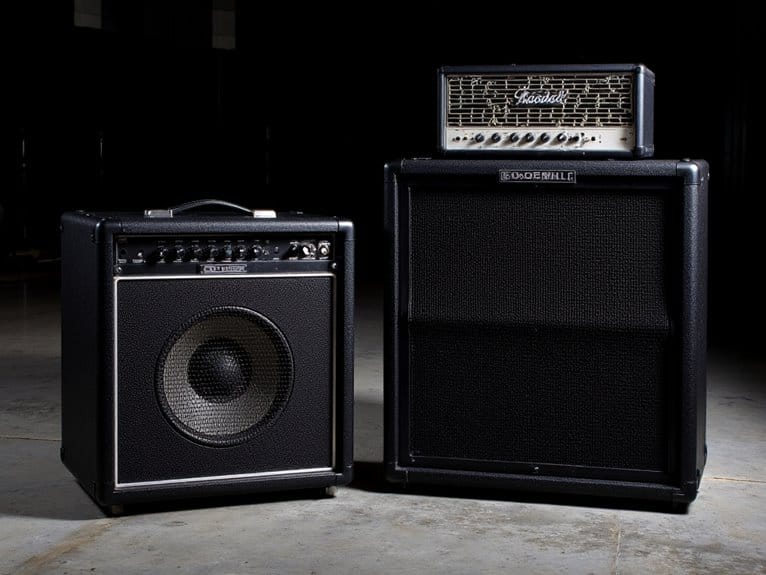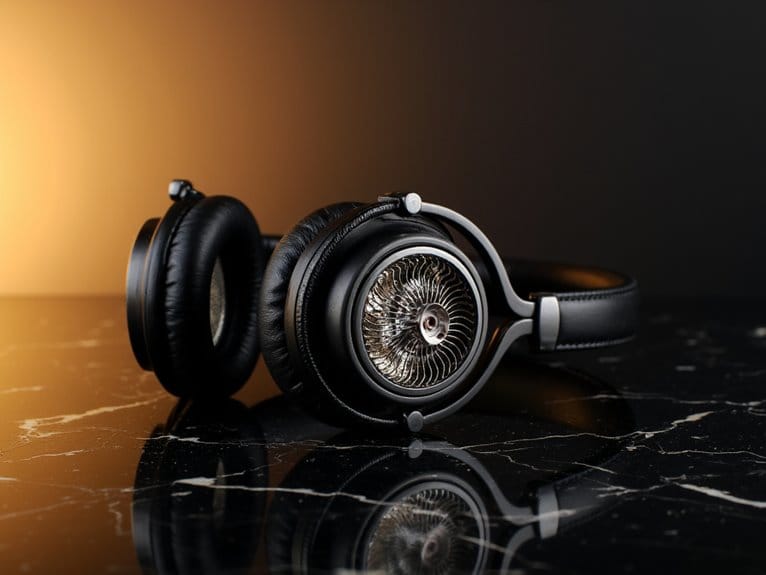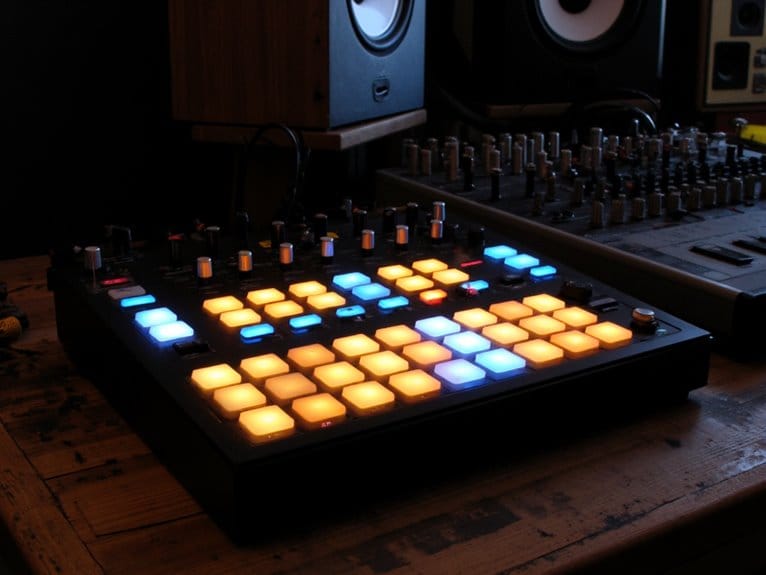Understanding Headphone Amplifier Specifications
Understanding headphone amplifier specs requires grasping three key relationships: impedance matching, where your amp’s output impedance should be eight times lower than your headphones’ impedance to prevent muddy bass and distorted highs; sensitivity ratings that determine power needs, with high-sensitivity models around 110 dB/mW requiring less juice than low-sensitivity units at 90 dB/mW; and the voltage-versus-current balance, since high-impedance cans need substantial voltage swings while low-impedance drivers demand robust current delivery to avoid clipping during complex passages-and there’s more to take into account.
We are supported by our audience. When you purchase through links on our site, we may earn an affiliate commission, at no extra cost for you. Learn more.
Notable Insights
- Impedance matching follows the “1/8 rule”: amplifier output impedance should be eight times lower than headphone impedance.
- High-sensitivity headphones (110 dB/mW) need less power while low-sensitivity models (90 dB/mW) require robust amplification.
- High-impedance headphones need substantial voltage; low-impedance models require strong current delivery to prevent distortion.
- Proper gain control reduces background noise and allows precise volume adjustments matching your headphone’s efficiency.
- Lower output impedance creates higher damping factors, resulting in better driver control and cleaner sound reproduction.
Impedance Matching and Its Impact on Sound Quality
When I first started diving into headphone amplifiers, I’ll admit I was completely baffled by all the impedance talk-it seemed like audiophiles were speaking in code about ohms and matching ratios.
Audiophiles weren’t speaking in code-they were discussing the crucial impedance matching that separates great sound from mediocre audio.
What I’ve learned is that impedance matching fundamentally determines whether you’ll hear your music as intended, or endure muddy bass and distorted highs that’ll make you question your entire setup.
The golden rule here involves the “1/8 rule,” where your amplifier’s output impedance should be at least eight times lower than your headphones’ impedance.
Different impedance types require specific calibration techniques to achieve ideal performance, and mismatching these creates frequency response issues that affect everything from bass control to overall clarity, making proper pairing essential for maximizing your audio investment. High-sensitivity headphones in the 16-32 ohm range typically achieve optimal performance when connected directly to quality source devices, eliminating the need for additional amplification. This becomes especially critical with IEMs, where low impedance drivers demand precise amplifier control to prevent distortion and maintain accurate sound reproduction.
Sensitivity Ratings and Power Requirements
After wrestling with impedance matching, I discovered that sensitivity ratings represent the other half of the amplification equation-they’re fundamentally your headphones’ efficiency report card, telling you exactly how much sound pressure level they’ll produce from each milliwatt of power you feed them.
Sensitivity measurement techniques reveal essential amplification insights:
- Power requirements scale inversely – High-sensitivity models (110 dB/mW) need minimal power, while low-sensitivity units (90 dB/mW) demand robust amplification.
- Voltage calculations matter – 16Ω headphones need 126mV for 1mW, but 600Ω models require 775mV.
- Portable compatibility depends on efficiency – Smartphones struggle with low-sensitivity, high-impedance combinations.
- Specification clarity varies – dB/V ratings appear higher than dB/mW, creating marketing confusion.
Understanding these efficient amplification strategies prevents underpowering your headphones and guarantees peak performance matching. For audiophile-quality sound under budget constraints, a minimum of 1 watt of clean power is recommended for high-impedance headphones to achieve proper dynamic range without distortion. Modern amplifiers with ES9038PRO chips deliver exceptional clarity by supporting high-resolution formats up to 768kHz/32Bit for the most demanding listening applications.
Voltage Output Vs Current Delivery in Amplifier Design
Two fundamental electrical principles drive every headphone amplifier’s performance, and I’ve learned that understanding the voltage-versus-current relationship isn’t just academic theory-it’s the key to matching your gear properly and avoiding the frustration of underpowered headphones or distorted audio.
When you examine voltage ratings, you’ll discover that high-impedance headphones like the HD800 demand substantial voltage swings to reach adequate loudness levels, while low-impedance models require robust current specifications for clean power delivery.
I’ve found that amplifier designs must balance these competing demands carefully, as voltage capacity affects high-impedance performance while current delivery determines how well your amp handles demanding, low-impedance loads without introducing distortion or clipping during dynamic musical passages. Budget amplifiers can achieve ultra-low distortion rates of 0.0003% while supporting wide impedance ranges from 16-300Ω, proving that proper electrical design doesn’t require premium pricing.
Proper impedance matching between your headphones and amplifier ensures optimal sound quality and prevents the tonal changes that can occur when electrical characteristics aren’t properly aligned.
Gain Control and Volume Management Strategies
Beyond the voltage and current considerations that determine an amplifier’s raw power capabilities, I’ve discovered that gain control represents perhaps the most misunderstood yet impactful aspect of headphone amplifier operation, directly affecting everything from background noise levels to your maximum safe listening volumes.
Effective gain settings require strategic thinking:
- Match your source voltage – Set gain to complement your DAC’s output for ideal dynamic range.
- Balance noise management – Lower gain reduces hiss but may limit maximum output.
- Optimize volume knob positioning – Proper gain lets you use the middle range for better precision.
- Consider headphone sensitivity – High-efficiency headphones need lower gain to prevent early distortion.
Getting this balance right dramatically improves audio clarity while protecting both your hearing and equipment. Professional 250-ohm headphones typically require proper matching of impedance to amplification for superior sound fidelity and optimal performance in studio environments.
Output Impedance and Damping Factor Considerations
While most enthusiasts obsess over power output numbers, I’ve learned that output impedance often matters more for actual sound quality, since this seemingly minor specification determines how effectively your amplifier controls your headphones’ drivers and whether you’ll hear the music as intended.
You’ll want your amp’s output impedance to be markedly lower than your headphones’ impedance-ideally one-eighth or less-to avoid frequency response distortions, particularly in bass regions where output impedance effects become most apparent.
The damping factor significance becomes clear when you realize it’s the ratio between these impedances, and higher damping factors translate to tighter driver control, more accurate transients, and cleaner sound reproduction across the frequency spectrum.
On a final note
You’ll find that understanding these amplifier specifications isn’t rocket science, though it might feel like it at first. Once you’ve grasped impedance matching, power requirements, and output characteristics, you’re equipped to make informed decisions about your audio setup. Don’t get caught up in spec-sheet obsession, but do pay attention to how these numbers translate to real-world performance with your specific headphones.

